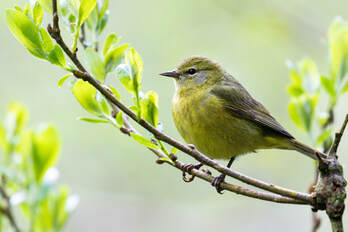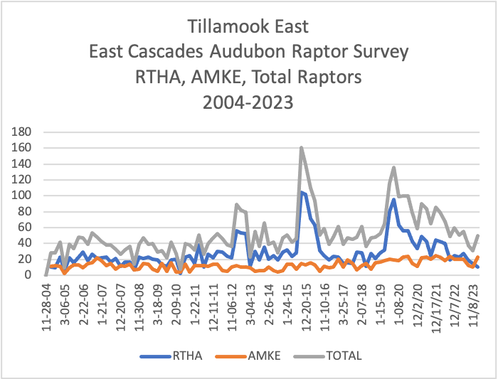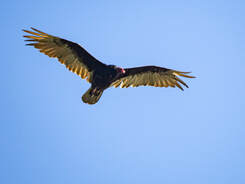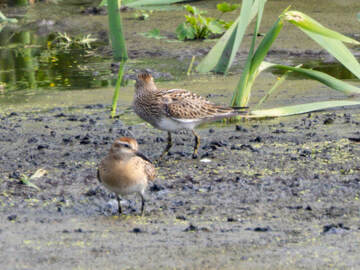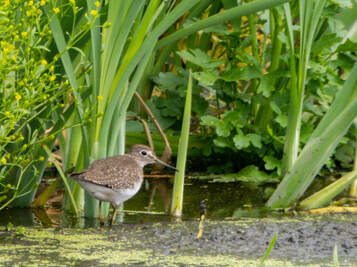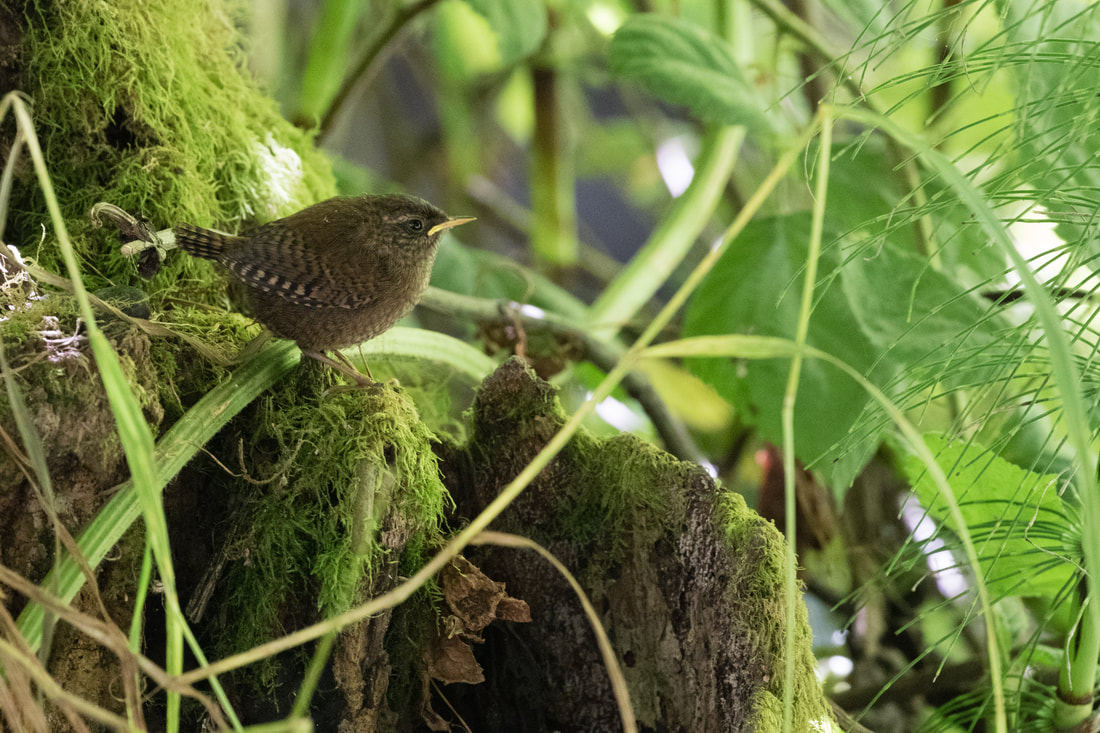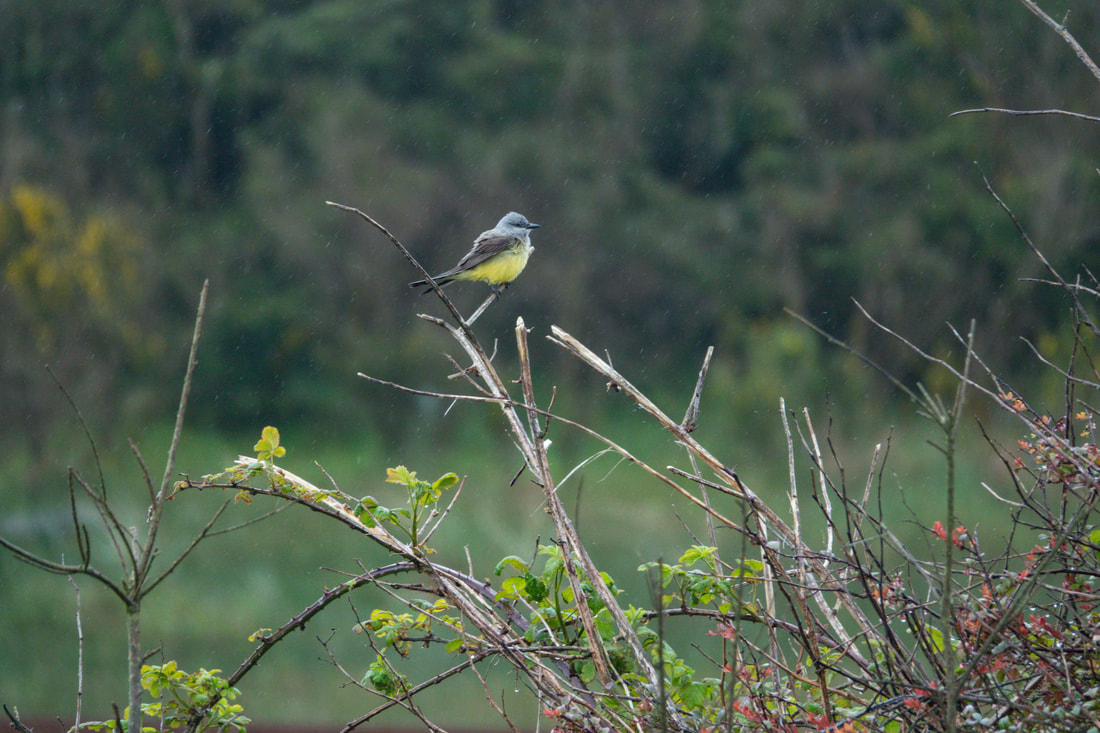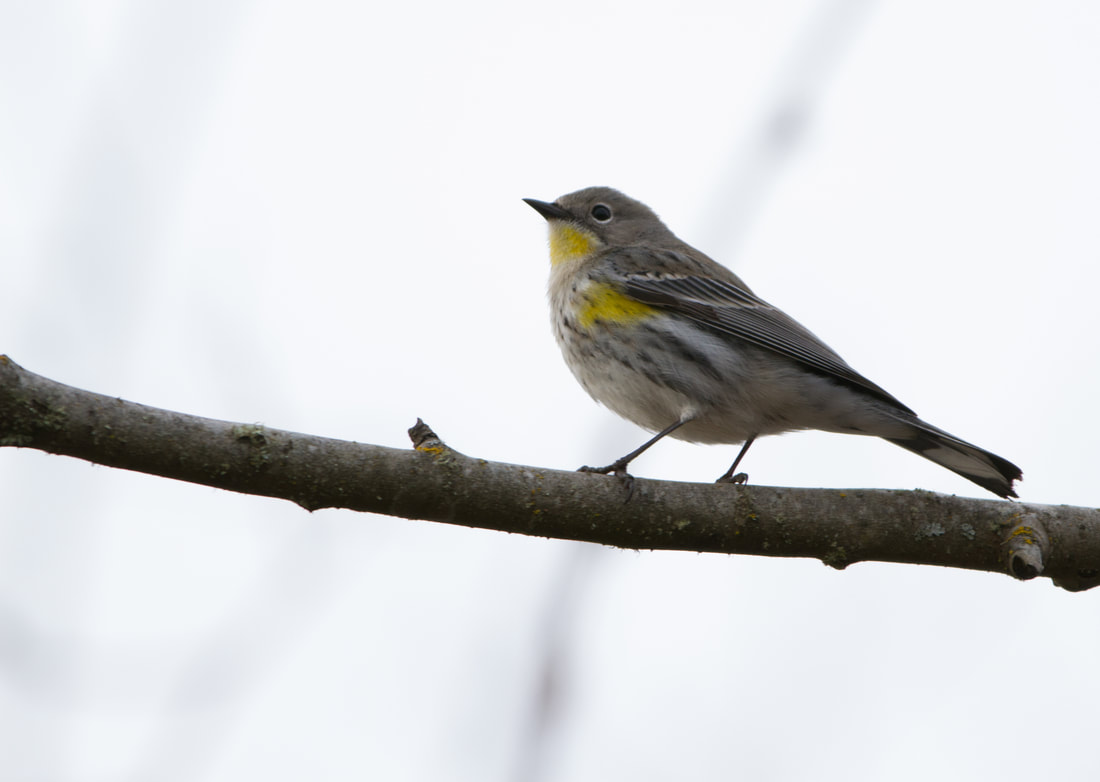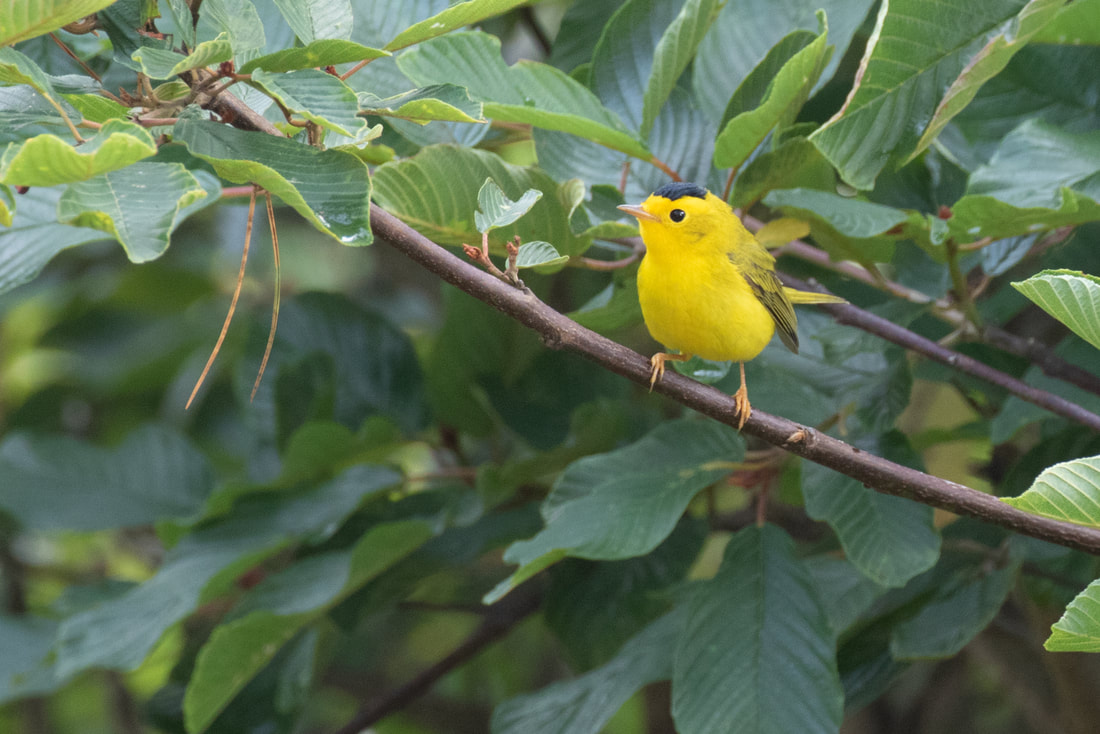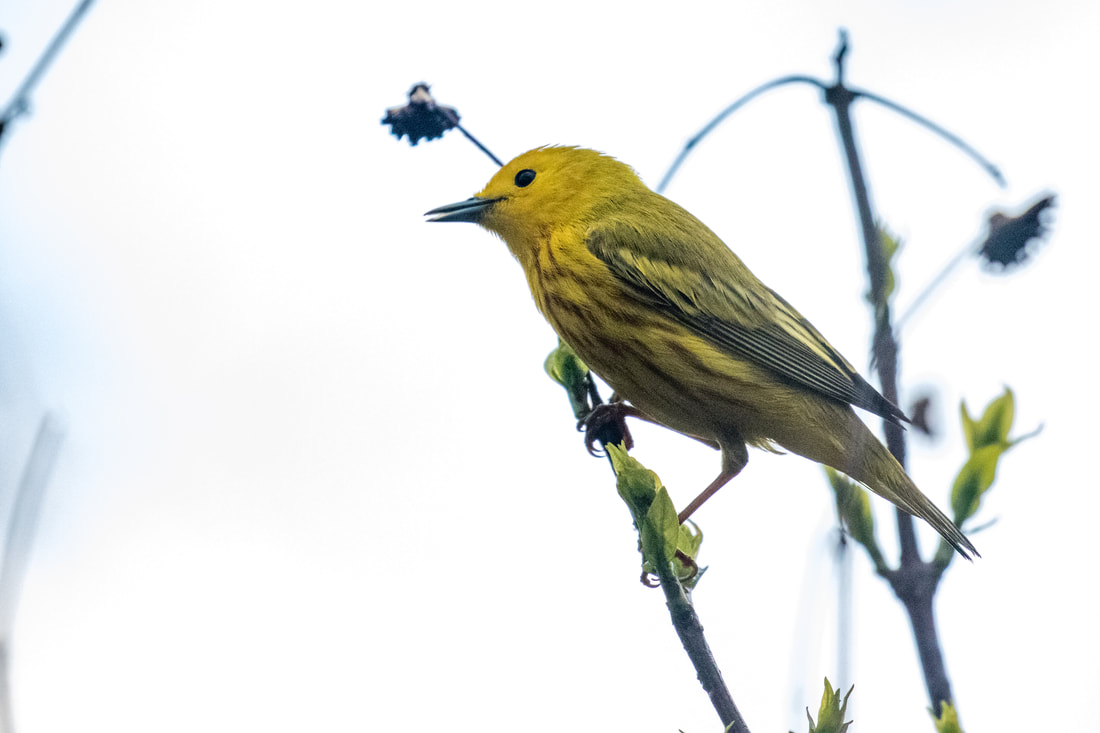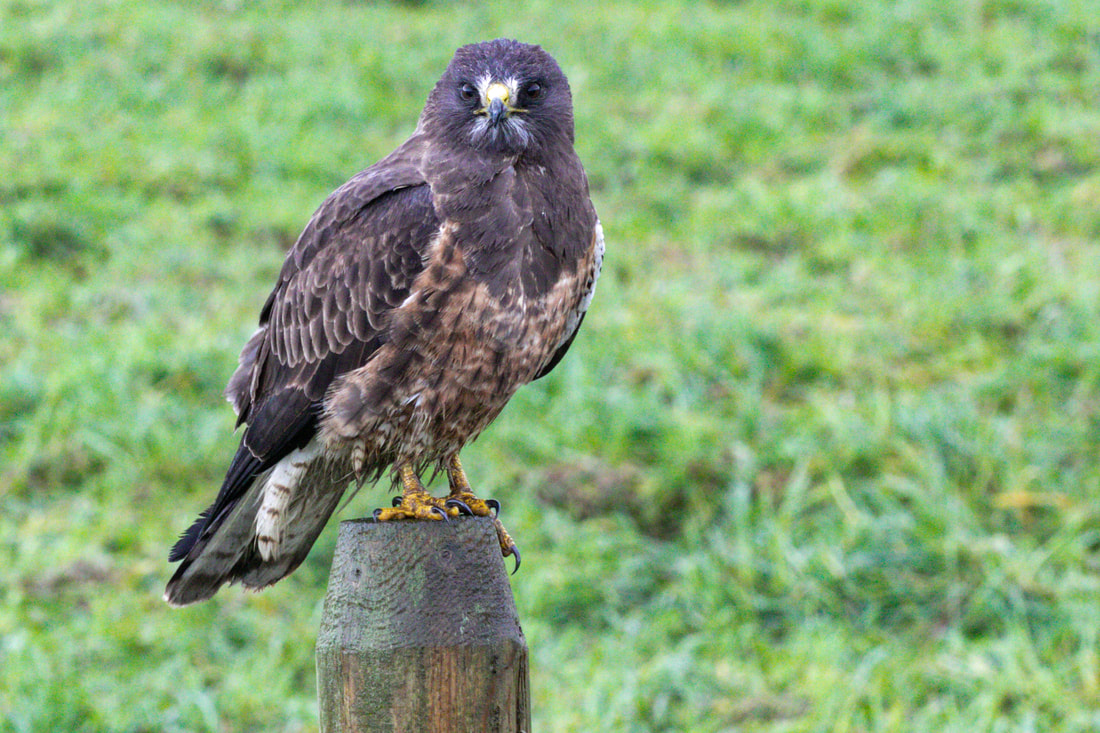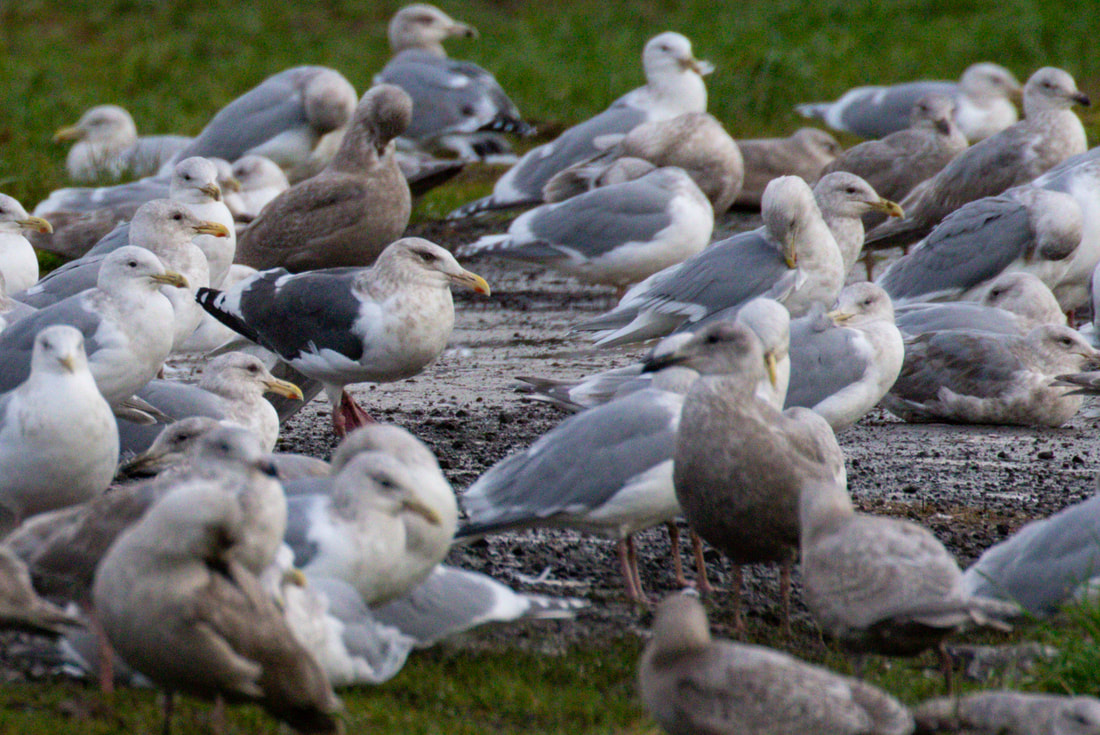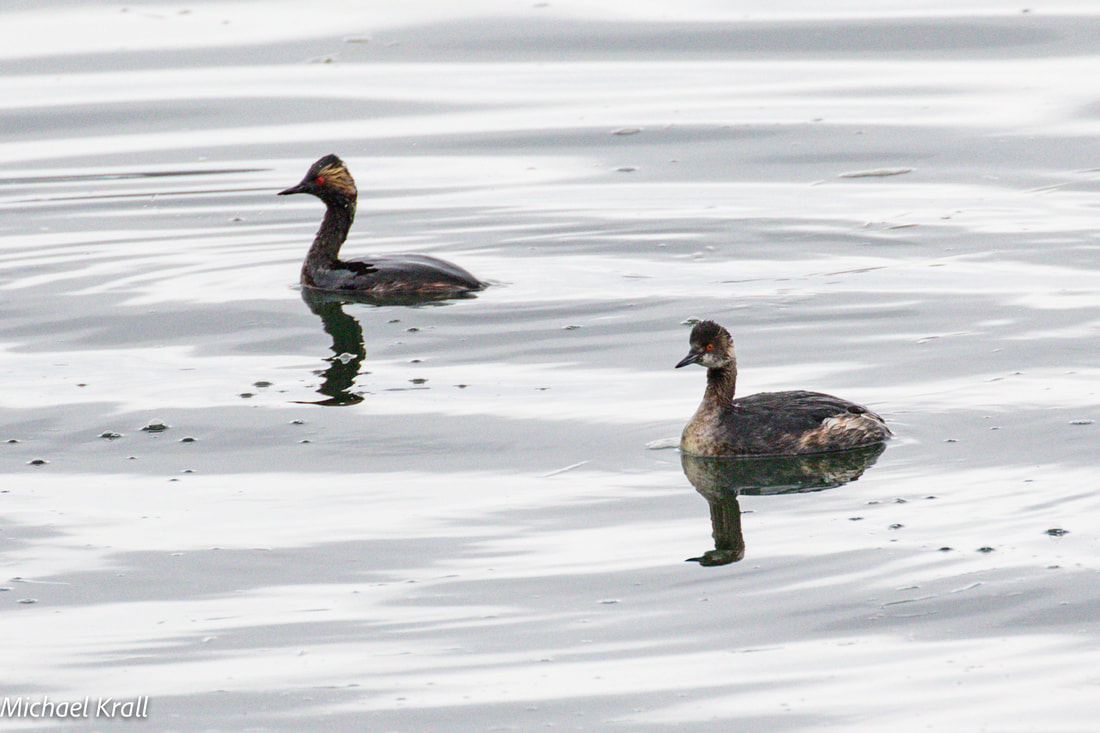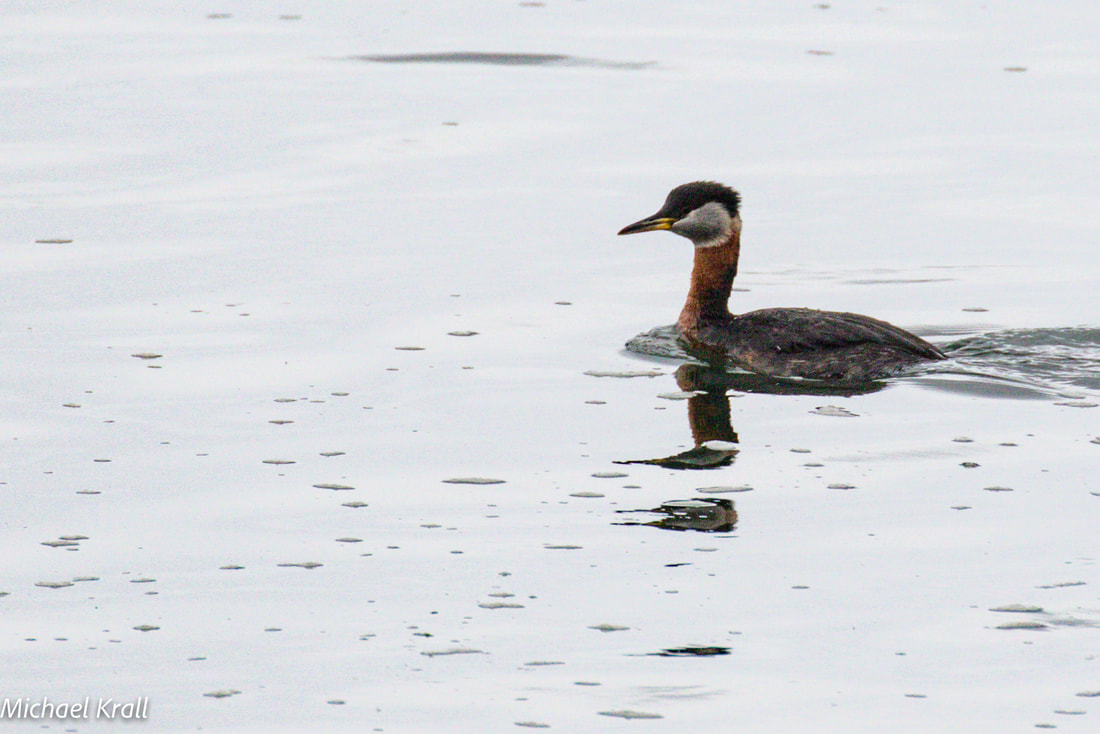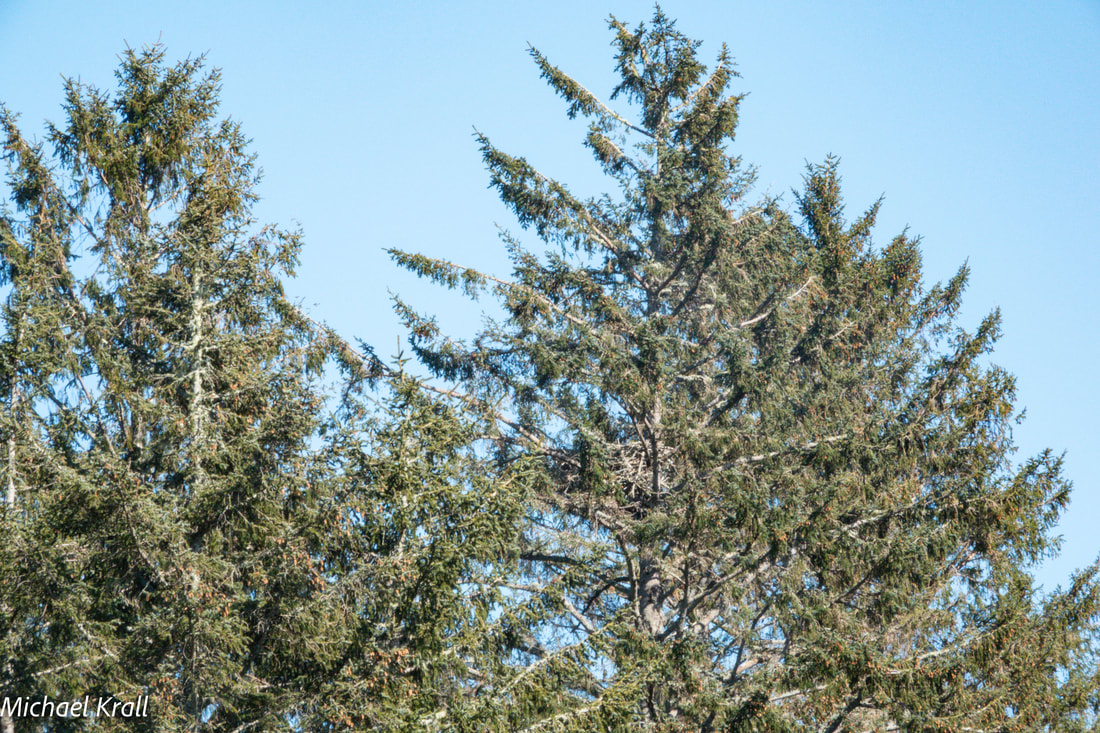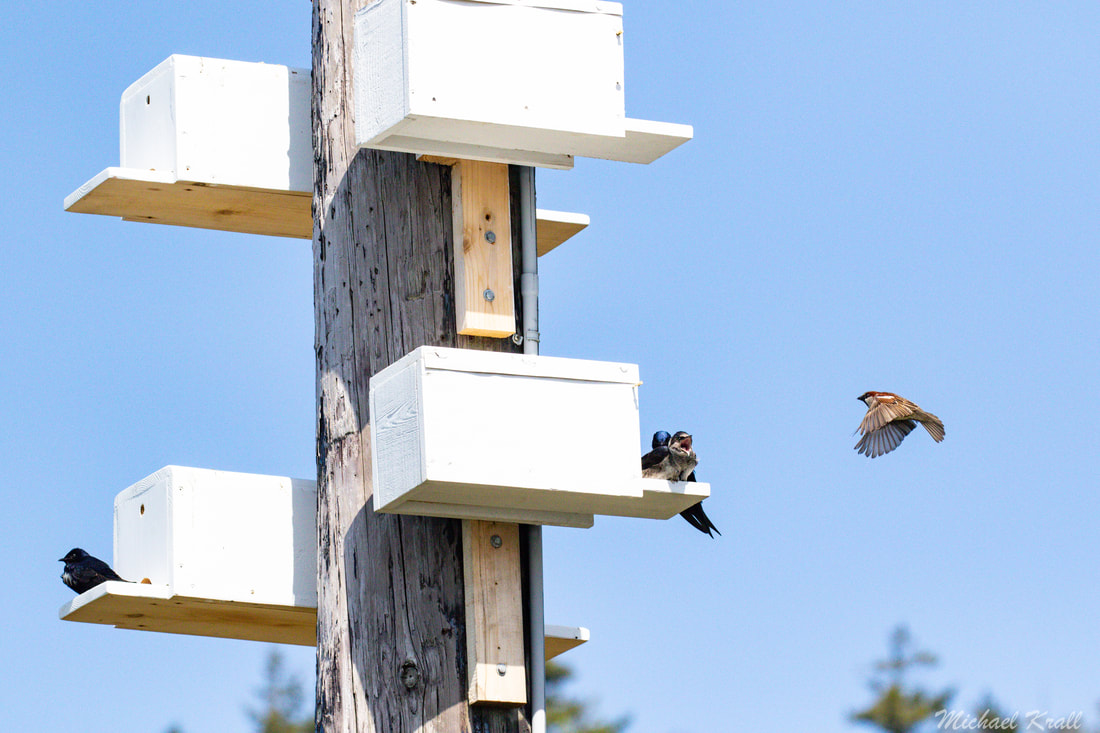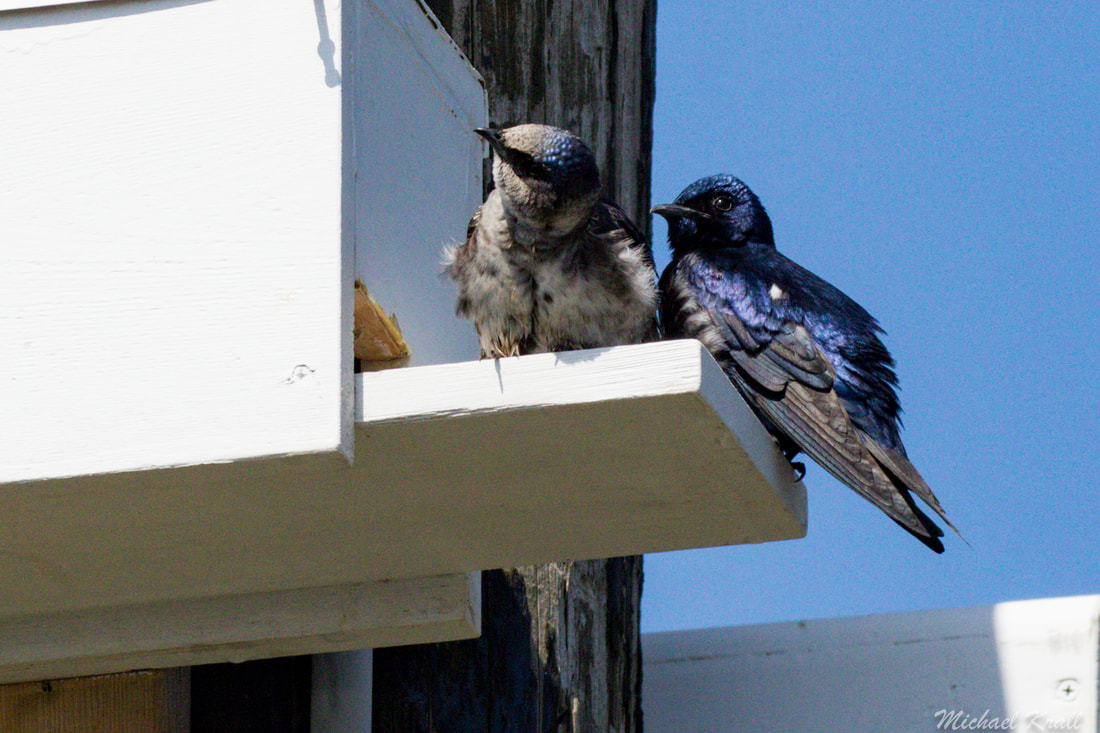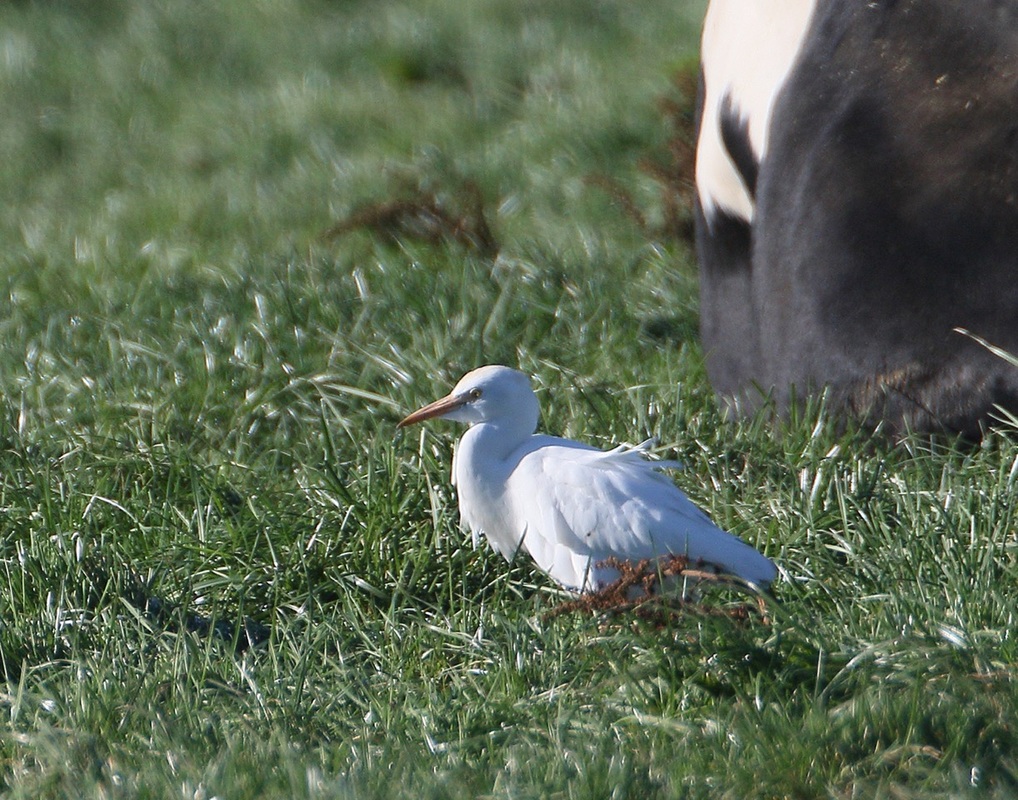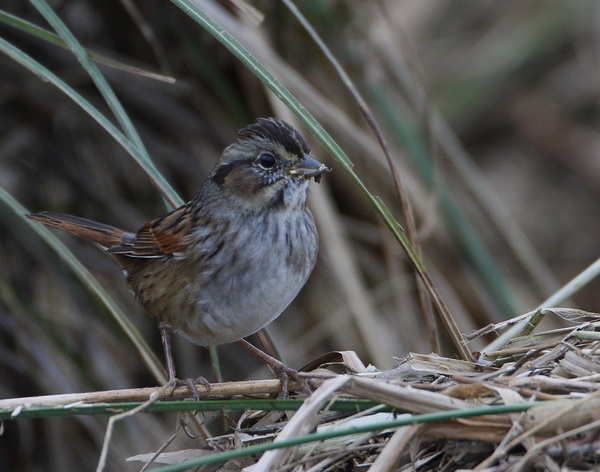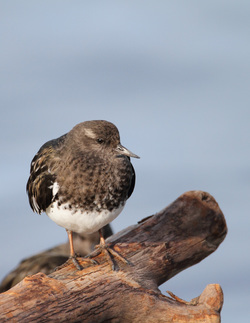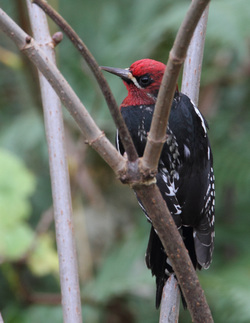Last Update: April 5, 2024
We encourage you to check back regularly. If you have comments, contributions, sightings, suggestions or if you notice anything that needs fixing, please let us know! We are here for you.
We encourage you to check back regularly. If you have comments, contributions, sightings, suggestions or if you notice anything that needs fixing, please let us know! We are here for you.
You know it is spring, when the first warblers arrive. We heard Orange-crowned warblers two weeks ago along Netarts Bay. Soon these harbingers will be joined by Wilson’s, Yellow, Black-throated Gray, and Hermit warblers. Kilchis Point Reserve, north of Tillamook, is a good place to listen for warblers. Some warblers, such Hermit and Black-throated Gray, prefer tree tops and are hard to see.
The Osprey are also back! We watched an osprey valiantly trying to get lift while carrying a large lamprey eel, in the Sand Lake estuary. The osprey dropped the lamprey, and it was immediately scooped up by a Bald Eagle.
Sand Lake is a pristine coastal estuary located between Sitka Sedge State Natural Area and Clay Meyers State Natural Area at Whalen Island. There are trails in both areas that wind through dune, beach, and shore pine forest habitat. The trails overlook the mudflats, where you can search for shorebirds migrating north. Check the forest sections for warblers and bushtits.
A friend saw an osprey with nesting material near Cape Meares village. There has been an osprey nest in the general area for the last few years. One year it was along the road to Cape Meares village, but best seen from Bayocean dike road.
Access to Bay Ocean spit road beyond the parking lot will be limited until fall 2025, as the Army Corps of Engineers is repairing the Tillamook Bay south jetty. However, you can still access the beach and dunes from the parking lot. The willows along the entrance road can be good for warblers, and you can view water birds in Cape Meares Lake.
Happy spring birding!
The Osprey are also back! We watched an osprey valiantly trying to get lift while carrying a large lamprey eel, in the Sand Lake estuary. The osprey dropped the lamprey, and it was immediately scooped up by a Bald Eagle.
Sand Lake is a pristine coastal estuary located between Sitka Sedge State Natural Area and Clay Meyers State Natural Area at Whalen Island. There are trails in both areas that wind through dune, beach, and shore pine forest habitat. The trails overlook the mudflats, where you can search for shorebirds migrating north. Check the forest sections for warblers and bushtits.
A friend saw an osprey with nesting material near Cape Meares village. There has been an osprey nest in the general area for the last few years. One year it was along the road to Cape Meares village, but best seen from Bayocean dike road.
Access to Bay Ocean spit road beyond the parking lot will be limited until fall 2025, as the Army Corps of Engineers is repairing the Tillamook Bay south jetty. However, you can still access the beach and dunes from the parking lot. The willows along the entrance road can be good for warblers, and you can view water birds in Cape Meares Lake.
Happy spring birding!
2023 Tillamook CBC
The 2023 CBC was very successful! Thanks to Allison Anholt for leading it this year and for providing the summary below.
Overall, 25 field observers and 3 feeder-watchers counted 39,266 individual birds across 148 species on the count day. We also recorded 4 count week-only birds (Clark's Grebe, Harlequin Duck, Yellow warbler and Canada Jay). The sum total of 148 birds has only been beaten in two prior years since the count began in 1964: 2010 (155 species) and 2004 (154 species) and matched in 2006 and 2011.
Particularly notable species were super high counts of Black Phoebe and Mourning Dove (see below), and records of Northern Waterthrush and Wilson's Warbler. We also saw 8 White-tailed Kites, the highest number since 2015.
Since 1964, 238 species have been recorded on the count- this doesn't include the different forms of dark-eyed juncos, for example, or when people record it as a greater/lesser scaup or gull species, etc. It also combines the former Northwestern Crow into American Crow. This year, we recorded 62% of these species. In the full dataset, 24 species have only been recorded one time (3 snowy owls were seen in 1966) We did not record any new species to the count this year, though we recorded a whopping 19 high-counts- the highest number of individuals recorded of a species ever in the history of the count.
High Count Species in 2023:
Surf Scoter- 1496 (previous record 1140 in 2013)
Bufflehead- 2503 (previous record 1795 in 2011)
Barrow's Goldeneye- 6 (previous record 3, set last year)
Greater Yellowlegs- 40 (previous record 14, set in 2007)
Rock Pigeon- 366 (previous record 265 set in 2004 and 1998)
Mourning Dove- 12 (previous high count of 4, set in 2017)
Red-breasted Sapsucker- 5 (previous record 3, set last year)
Hairy Woodpecker- 26 (previous record 15, set last year)
Black Phoebe- 77 (previous record 59, set last year)
Western Scrub Jay- 89 (previous record 59, set last year)
Common Raven- 95 (previous record 89, set in 2018)
Black-capped Chickadee- 243 (previous record 140, set last year)
Red-breasted Nuthatch- 78 (previous record only 25, set in 1990)
Northern Waterthrush- 1 (seen during count week last year, and seen only once before, during the count in 1995)
Townsend's Warbler- 97 (previous record 81, set last year)
Wilson's Warbler- 2 (only seen once before, in 1980)
Fox Sparrow- 497 (previous record 392, set in 1984)
Dark-eyed Junco- 895 (previous record 840, set in 1971)
Spotted Towhee- 219 (previous record 119 set in 1992)
There were a few misses as well- Canada Jay, which we've seen 29 of 59 prior years, wasn't spotted until the next day to be counted on our count week list, Rough-legged Hawk, which we've seen 43 of the 59 years, and Great Horned Owl, which we've spotted 36 times in the past.
If you are interested in participating in the 2024 CBC, contact Allison Anholt at [email protected]
The 2023 CBC was very successful! Thanks to Allison Anholt for leading it this year and for providing the summary below.
Overall, 25 field observers and 3 feeder-watchers counted 39,266 individual birds across 148 species on the count day. We also recorded 4 count week-only birds (Clark's Grebe, Harlequin Duck, Yellow warbler and Canada Jay). The sum total of 148 birds has only been beaten in two prior years since the count began in 1964: 2010 (155 species) and 2004 (154 species) and matched in 2006 and 2011.
Particularly notable species were super high counts of Black Phoebe and Mourning Dove (see below), and records of Northern Waterthrush and Wilson's Warbler. We also saw 8 White-tailed Kites, the highest number since 2015.
Since 1964, 238 species have been recorded on the count- this doesn't include the different forms of dark-eyed juncos, for example, or when people record it as a greater/lesser scaup or gull species, etc. It also combines the former Northwestern Crow into American Crow. This year, we recorded 62% of these species. In the full dataset, 24 species have only been recorded one time (3 snowy owls were seen in 1966) We did not record any new species to the count this year, though we recorded a whopping 19 high-counts- the highest number of individuals recorded of a species ever in the history of the count.
High Count Species in 2023:
Surf Scoter- 1496 (previous record 1140 in 2013)
Bufflehead- 2503 (previous record 1795 in 2011)
Barrow's Goldeneye- 6 (previous record 3, set last year)
Greater Yellowlegs- 40 (previous record 14, set in 2007)
Rock Pigeon- 366 (previous record 265 set in 2004 and 1998)
Mourning Dove- 12 (previous high count of 4, set in 2017)
Red-breasted Sapsucker- 5 (previous record 3, set last year)
Hairy Woodpecker- 26 (previous record 15, set last year)
Black Phoebe- 77 (previous record 59, set last year)
Western Scrub Jay- 89 (previous record 59, set last year)
Common Raven- 95 (previous record 89, set in 2018)
Black-capped Chickadee- 243 (previous record 140, set last year)
Red-breasted Nuthatch- 78 (previous record only 25, set in 1990)
Northern Waterthrush- 1 (seen during count week last year, and seen only once before, during the count in 1995)
Townsend's Warbler- 97 (previous record 81, set last year)
Wilson's Warbler- 2 (only seen once before, in 1980)
Fox Sparrow- 497 (previous record 392, set in 1984)
Dark-eyed Junco- 895 (previous record 840, set in 1971)
Spotted Towhee- 219 (previous record 119 set in 1992)
There were a few misses as well- Canada Jay, which we've seen 29 of 59 prior years, wasn't spotted until the next day to be counted on our count week list, Rough-legged Hawk, which we've seen 43 of the 59 years, and Great Horned Owl, which we've spotted 36 times in the past.
If you are interested in participating in the 2024 CBC, contact Allison Anholt at [email protected]
Tillamook East Raptor Route
Under the auspices of the East Cascades Audubon Society and the direction of Jeff Fleischer, raptor surveys in the east Tillamook area have been on-going since 2004, with over 90 surveys completed in total. They are performed monthly from November to March (Nov and March being optional months) and nearly all surveys have been completed. This survey covers the same 56 mile route every time. When performing the surveys, it is always interesting, and remarkable, to experience the different numbers month to month and year to year.
The 12/8/2023 survey, experienced the lowest number of Red-tailed Hawks in the eight or so years since Kathy and Michael Krall have done the survey, ten hawks. We have had as many as 104 RTHAs on this route! This prompted me to look through the data and produce some graphs. What I found was somewhat reassuring: there is amazing variation year to year with some very low years and some extremely high years, but overall, the numbers do not show a declining trend. In the early years of the surveys, there were several in the 10 and 11 range and there were even 4 in the single digits with the lowest ever being 2 on 3/8/2010! RTHAs show much more variation than do American Kestrels. Other raptors in the area are in much smaller numbers (RTHA + AMKE account for 80%, on average, of the raptors seen on our route), and thus the variation is greater from count to count. Even White-tailed Kite, which feels like it is in decline in the count, actually shows numbers not too dissimilar to 10 and 15 years ago, although they are lower than they were 5-8 years ago when their numbers were higher than the 20 year average. Below is a graph of the RTHAs and American Kestrels. Other graphs can be seen here.
Under the auspices of the East Cascades Audubon Society and the direction of Jeff Fleischer, raptor surveys in the east Tillamook area have been on-going since 2004, with over 90 surveys completed in total. They are performed monthly from November to March (Nov and March being optional months) and nearly all surveys have been completed. This survey covers the same 56 mile route every time. When performing the surveys, it is always interesting, and remarkable, to experience the different numbers month to month and year to year.
The 12/8/2023 survey, experienced the lowest number of Red-tailed Hawks in the eight or so years since Kathy and Michael Krall have done the survey, ten hawks. We have had as many as 104 RTHAs on this route! This prompted me to look through the data and produce some graphs. What I found was somewhat reassuring: there is amazing variation year to year with some very low years and some extremely high years, but overall, the numbers do not show a declining trend. In the early years of the surveys, there were several in the 10 and 11 range and there were even 4 in the single digits with the lowest ever being 2 on 3/8/2010! RTHAs show much more variation than do American Kestrels. Other raptors in the area are in much smaller numbers (RTHA + AMKE account for 80%, on average, of the raptors seen on our route), and thus the variation is greater from count to count. Even White-tailed Kite, which feels like it is in decline in the count, actually shows numbers not too dissimilar to 10 and 15 years ago, although they are lower than they were 5-8 years ago when their numbers were higher than the 20 year average. Below is a graph of the RTHAs and American Kestrels. Other graphs can be seen here.
Tillamook Birds
Fall shorebird migration begins in early summer, but continues into October and even early November along the Tillamook coast. Shorebirds use a variety of habitats, but most can be found on ocean beaches at least some of the time. Sanderlings, for example, love the shoreline, and can often be found racing the waves along the beach at the north end of Sitka Sedge State State Natural Area, or along Manzanita beach, despite the crowds and dogs. If you are lucky, you may see a Baird’s Sandpiper or a Ruddy Turnstone mixed in with the Sanderlings and Western Sandpipers. Another place to try is the Nestucca Bay State Park Boat launch area. There are mudflats and beaches both south and north of the parking area, where shorebirds are often seen. However, it helps to pay attention to the tides. If the tide is too low, the birds will be too far away to see well. If the tide is too high, they will have moved elsewhere. Often the best time is on the incoming tide.
Black Turnstone flocks are often found on jetty rocks. However, they can also be found many days at the Netarts Boat Basin, or on the rocks along Netarts Bay Rd. Another place to look is the Barview Jetty, north of Garibaldi. At that site, you may also find Wandering Tattler, Rock Sandpiper or Surfbird.
Looking for an American Dipper? These cute birds are uncommon year round Oregon residents. Luckily, there are good spots to find them in Tillamook county. Check the Mapes Creek boat launch area, at the intersection of Kilchis River Road and Kilchis Forest Road. From the parking area, walk back up onto the bridge over the Kilchis river, and check both directions for whitewash on the river rocks. No luck? Check Mapes Creek where it flows into the Kilchis River. There are also often American Dippers in the Kilchis River County Campground.
Tillamook County has numerous wonderful birds in its several biomes. As of May 2023 there are 385 different Tillamook species listed on eBird. While some of these are very rare and unexpected, many are seen every year. There is one avid Tillamook eBirder who has seen 317 (and counting...) of these species! To further explore Tillamook County sightings, visit eBird. For more information on specific coastal Tillamook birds, take a look at our Where to Bird section, and check out the birds section of Netarts Bay Today. How many different species can you identify?
Fall shorebird migration begins in early summer, but continues into October and even early November along the Tillamook coast. Shorebirds use a variety of habitats, but most can be found on ocean beaches at least some of the time. Sanderlings, for example, love the shoreline, and can often be found racing the waves along the beach at the north end of Sitka Sedge State State Natural Area, or along Manzanita beach, despite the crowds and dogs. If you are lucky, you may see a Baird’s Sandpiper or a Ruddy Turnstone mixed in with the Sanderlings and Western Sandpipers. Another place to try is the Nestucca Bay State Park Boat launch area. There are mudflats and beaches both south and north of the parking area, where shorebirds are often seen. However, it helps to pay attention to the tides. If the tide is too low, the birds will be too far away to see well. If the tide is too high, they will have moved elsewhere. Often the best time is on the incoming tide.
Black Turnstone flocks are often found on jetty rocks. However, they can also be found many days at the Netarts Boat Basin, or on the rocks along Netarts Bay Rd. Another place to look is the Barview Jetty, north of Garibaldi. At that site, you may also find Wandering Tattler, Rock Sandpiper or Surfbird.
Looking for an American Dipper? These cute birds are uncommon year round Oregon residents. Luckily, there are good spots to find them in Tillamook county. Check the Mapes Creek boat launch area, at the intersection of Kilchis River Road and Kilchis Forest Road. From the parking area, walk back up onto the bridge over the Kilchis river, and check both directions for whitewash on the river rocks. No luck? Check Mapes Creek where it flows into the Kilchis River. There are also often American Dippers in the Kilchis River County Campground.
Tillamook County has numerous wonderful birds in its several biomes. As of May 2023 there are 385 different Tillamook species listed on eBird. While some of these are very rare and unexpected, many are seen every year. There is one avid Tillamook eBirder who has seen 317 (and counting...) of these species! To further explore Tillamook County sightings, visit eBird. For more information on specific coastal Tillamook birds, take a look at our Where to Bird section, and check out the birds section of Netarts Bay Today. How many different species can you identify?
Birding Tillamook County by Paddle Board or Kayak
Have you ever considered birding Tillamook County by Paddle Board or Kayak? Local birder Cliff Cordy has and has prepared a guide for those similarly inclined. Check it out here.
Have you ever considered birding Tillamook County by Paddle Board or Kayak? Local birder Cliff Cordy has and has prepared a guide for those similarly inclined. Check it out here.
May-June 2023
Our beautiful summer warblers have returned! Two favorites with similar buzzy songs are heard more often then they are seen, as they love the treetops. Hermit warblers have yellow faces and black throats, somewhat like a chickadee. Black-throated Gray warblers are black, gray and white, and also have a black throat. They have tiny yellow “headlights” that are hard to see. Scroll down this site for images of these beauties. Look and listen for warblers at Cape Meares, along the trails near the lighthouse.
Band-tailed pigeons may be visiting your feeders again. With their bright yellow feet and beak, they are easy to distinguish from Eurasian Collared-Doves. They might be found at the Whiskey Creek fish hatchery along Netarts Bay.
In the northern part of the county, Tohl Dike path, near Alder Creek farm just north of Nehalem, is another good place to listen and look for warblers. If you are lucky, you might also hear or see Red-breasted Nuthatches or even a Sora or Virginia Rail.
Our beautiful summer warblers have returned! Two favorites with similar buzzy songs are heard more often then they are seen, as they love the treetops. Hermit warblers have yellow faces and black throats, somewhat like a chickadee. Black-throated Gray warblers are black, gray and white, and also have a black throat. They have tiny yellow “headlights” that are hard to see. Scroll down this site for images of these beauties. Look and listen for warblers at Cape Meares, along the trails near the lighthouse.
Band-tailed pigeons may be visiting your feeders again. With their bright yellow feet and beak, they are easy to distinguish from Eurasian Collared-Doves. They might be found at the Whiskey Creek fish hatchery along Netarts Bay.
In the northern part of the county, Tohl Dike path, near Alder Creek farm just north of Nehalem, is another good place to listen and look for warblers. If you are lucky, you might also hear or see Red-breasted Nuthatches or even a Sora or Virginia Rail.
March 2023
It’s time to look up! Turkey Vultures and Osprey will be arriving this month.
Turkey Vultures soar with their wings tilted up, in a dihedral pattern. They are carrion feeders, and lack feathers on their heads, an adaptation that keeps their heads relatively clean. They are known to have a keen sense of smell and can find dead animals even when hidden.
It doesn’t seem like spring is coming soon, with our historic February snowfall. However, Rufous Hummingbirds will soon be joining the overwintering Anna’s Hummingbirds, no doubt fighting over the best spots at your hummingbird feeders. There has already been at least one county sighting.
An occasional swallow or two has also already been reported; most Violet-green and Tree Swallows will arrive early in March. Barn Swallows and Cliff Swallows follow later in the month.
It’s time to look up! Turkey Vultures and Osprey will be arriving this month.
Turkey Vultures soar with their wings tilted up, in a dihedral pattern. They are carrion feeders, and lack feathers on their heads, an adaptation that keeps their heads relatively clean. They are known to have a keen sense of smell and can find dead animals even when hidden.
It doesn’t seem like spring is coming soon, with our historic February snowfall. However, Rufous Hummingbirds will soon be joining the overwintering Anna’s Hummingbirds, no doubt fighting over the best spots at your hummingbird feeders. There has already been at least one county sighting.
An occasional swallow or two has also already been reported; most Violet-green and Tree Swallows will arrive early in March. Barn Swallows and Cliff Swallows follow later in the month.
September
The Oregon Birding Association held its annual meeting and field trips September 10 and 11. There were three field trips in Tillamook County, two to Sitka Sedge and one to the Garibaldi area including Bay City, Barview Jetty, and the Garibaldi Marina. Despite some wind and smokey skies, participation was good and some very fine birds were seen. Notable sightings were a Lapland Longspur at Sitka Sedge, and a Rock Sandpiper and Wandering Tattler at Barview.
Local birding has continued excellent with many sightings of American Pipit, and good views by many of Solitary Sandpiper and Sharp-tailed Sandpiper. Several people also had looks at a young Prairie Falcon, that passed through briefly. There have been a number of warbler reports, most of expected species, with a Tennessee Warbler reported September 22 at
Kilchis Point Reserve. Thanks to the many remarkable sightings by Cameron Cox.
The Oregon Birding Association held its annual meeting and field trips September 10 and 11. There were three field trips in Tillamook County, two to Sitka Sedge and one to the Garibaldi area including Bay City, Barview Jetty, and the Garibaldi Marina. Despite some wind and smokey skies, participation was good and some very fine birds were seen. Notable sightings were a Lapland Longspur at Sitka Sedge, and a Rock Sandpiper and Wandering Tattler at Barview.
Local birding has continued excellent with many sightings of American Pipit, and good views by many of Solitary Sandpiper and Sharp-tailed Sandpiper. Several people also had looks at a young Prairie Falcon, that passed through briefly. There have been a number of warbler reports, most of expected species, with a Tennessee Warbler reported September 22 at
Kilchis Point Reserve. Thanks to the many remarkable sightings by Cameron Cox.
August
There are so many fledgling and "hatch year" birds around, in various stages of development. It's fun to hear them learning, and often not quite getting, their songs. And so much begging for food! It's a kick to see their parents weaning them to independence. Young birds usually have different plumage from adults, and depending on their age may sport downy feathers and a yellowish "gape" at the base of their beaks, apparently a target for parental feeding.
There are so many fledgling and "hatch year" birds around, in various stages of development. It's fun to hear them learning, and often not quite getting, their songs. And so much begging for food! It's a kick to see their parents weaning them to independence. Young birds usually have different plumage from adults, and depending on their age may sport downy feathers and a yellowish "gape" at the base of their beaks, apparently a target for parental feeding.
Merry Migration
Spring 2022 migration is well under way. Many shorebirds are showing up along the coast and warblers are in evidence wherever there is fresh water and shelter. WHIMBRELS (Numenius phaeopus), large sandpipers with long down curved beaks, have been especially in evidence this early May. Several WESTERN KINGBIRDS ((Tyrannus verticalis), a rare visitor, have shown up as well. Get out there and enjoy (but bring your rain gear!).
Spring 2022 migration is well under way. Many shorebirds are showing up along the coast and warblers are in evidence wherever there is fresh water and shelter. WHIMBRELS (Numenius phaeopus), large sandpipers with long down curved beaks, have been especially in evidence this early May. Several WESTERN KINGBIRDS ((Tyrannus verticalis), a rare visitor, have shown up as well. Get out there and enjoy (but bring your rain gear!).
Wonderful World of Wood-Warblers
You can tell the season, based on visitations from members of the Wood-warblers (several Genera from the Families Parulidae and Peucedramidae). In Tillamook County we are lucky enough to have YELLOW-RUMPED WARBLERS (Dendroica coronata) year round. "Butter butts" come in two varieties, the more common Audubon's with their yellow throats. and the less common Myrtles with their dark cheeks and white throats. In the late summer through the month of May, we have the striking TOWNSEND'S WARBLER (Dendroica townsendi) with its bright yellow face and breast, olive to black cheek, and streaked flanks. Beginning in late March, listen for ORANGE-CROWNED WARBLERS (Vermivora celata), with their fast trilling song, as they become increasingly evident. Orange-crowned warblers can show up throughout the year. Although found throughout the US, the Pacific coast populations of this warbler are the brightest in color and show yellow and olive. If you are lucky, you may see orange in their crowns. Also in late March, COMMON YELLOW-THROATS (Geothlypis trichas) begin to show up. Present until October, these birds are more often heard than seen, with their distinctive "wichety wichety wichety" call. Males of this species have a broad black mask under a white stripe. While females lack these features, they too sport yellow throats, as well as yellow under their tails. The male voice will carry far- look for the singer further away than you might think.
In April, an abundance of warblers arrive. WILSON'S WARBLERS (Wilsonia pusilla) with their broad yellow eyebrows and black "skull caps" are very small and "cute" warblers. They are typically seen from April to September. HERMIT WARBLERS (Dendroica occidentalis) are unique to the west coast during the summer (late April through September). Their call is similar to Townsend's and these two species are known to hybridize. Look for a bright yellow crown and face, and black chins. YELLOW WARBLERS (Dendroica petechia) also arrive in late April and typically stay through September. They prefer brushy habitats especially along streams. These birds are yellow overall, as their name suggests. Males, however, have distinctive red streaks on their breasts (from which they get their species name, petechia). Occasionally seen are BLACK-THROATED GRAY WARBLERS (Dendroica nigrescens). Always a pleasure to see, these birds are entirely black and white, except for their distinctive yellow "headlights", small bright yellow spots just in front of their eyes. A few other species of warbler surprise us periodically, including PALM WARBLERS, usually seen in winter. Be on the look out for rarities. Enjoy the photos below, but better yet, go find them in the field!
You can tell the season, based on visitations from members of the Wood-warblers (several Genera from the Families Parulidae and Peucedramidae). In Tillamook County we are lucky enough to have YELLOW-RUMPED WARBLERS (Dendroica coronata) year round. "Butter butts" come in two varieties, the more common Audubon's with their yellow throats. and the less common Myrtles with their dark cheeks and white throats. In the late summer through the month of May, we have the striking TOWNSEND'S WARBLER (Dendroica townsendi) with its bright yellow face and breast, olive to black cheek, and streaked flanks. Beginning in late March, listen for ORANGE-CROWNED WARBLERS (Vermivora celata), with their fast trilling song, as they become increasingly evident. Orange-crowned warblers can show up throughout the year. Although found throughout the US, the Pacific coast populations of this warbler are the brightest in color and show yellow and olive. If you are lucky, you may see orange in their crowns. Also in late March, COMMON YELLOW-THROATS (Geothlypis trichas) begin to show up. Present until October, these birds are more often heard than seen, with their distinctive "wichety wichety wichety" call. Males of this species have a broad black mask under a white stripe. While females lack these features, they too sport yellow throats, as well as yellow under their tails. The male voice will carry far- look for the singer further away than you might think.
In April, an abundance of warblers arrive. WILSON'S WARBLERS (Wilsonia pusilla) with their broad yellow eyebrows and black "skull caps" are very small and "cute" warblers. They are typically seen from April to September. HERMIT WARBLERS (Dendroica occidentalis) are unique to the west coast during the summer (late April through September). Their call is similar to Townsend's and these two species are known to hybridize. Look for a bright yellow crown and face, and black chins. YELLOW WARBLERS (Dendroica petechia) also arrive in late April and typically stay through September. They prefer brushy habitats especially along streams. These birds are yellow overall, as their name suggests. Males, however, have distinctive red streaks on their breasts (from which they get their species name, petechia). Occasionally seen are BLACK-THROATED GRAY WARBLERS (Dendroica nigrescens). Always a pleasure to see, these birds are entirely black and white, except for their distinctive yellow "headlights", small bright yellow spots just in front of their eyes. A few other species of warbler surprise us periodically, including PALM WARBLERS, usually seen in winter. Be on the look out for rarities. Enjoy the photos below, but better yet, go find them in the field!
Rare Tillamook Birds
All birds are special...but some sightings are especially noteworthy. This winter we had some very cool visitors and this has continued this spring. Very recent unusual visitors include the Northern Parula Warbler at Sitka Sedge and an Acorn Woodpecker near Nehalem. There was also a Black-throated Sparrow at Sitka Sedge at the end of May.
On November 30, 2021 Kevin Scaldeferri spotted a SWAINSON'S HAWK (Buteo swainsoni) on Long Prairie Road. It is likely the same bird that was sighted nearby last year. Swainson's Hawks are rare in Tillamook County. This beauteous Buteo (pun intended) has been spotted fairly regularly in the same area since. Remarkably, on January 16, at the same location, Conor Scotland picked out a rare SLATY-BACKED GULL (Larus schistisagus) from within a large gull flock. It too has been seen by multiple observers on multiple days, although the gulls move around and this gull can be hard to pick from the flock at times. This gull is uncommon and local in Western Alaska, rare elsewhere but apparently increasingly seen in small numbers along the Pacific coast. To add to the excitement and fun, Cliff Cordy found a YELLOW-BILLED LOON (Gavia adamsii) on January 23rd. Seen initially looking east from Bay Ocean Spit, the loon showed itself well to many happy birders the following day at the Barview Tide Pool. This loon is a rare visitor from the north, normally expected only in Arctic Canada and on the coasts of Alaska and British Columbia. What will the next rare bird be?
All birds are special...but some sightings are especially noteworthy. This winter we had some very cool visitors and this has continued this spring. Very recent unusual visitors include the Northern Parula Warbler at Sitka Sedge and an Acorn Woodpecker near Nehalem. There was also a Black-throated Sparrow at Sitka Sedge at the end of May.
On November 30, 2021 Kevin Scaldeferri spotted a SWAINSON'S HAWK (Buteo swainsoni) on Long Prairie Road. It is likely the same bird that was sighted nearby last year. Swainson's Hawks are rare in Tillamook County. This beauteous Buteo (pun intended) has been spotted fairly regularly in the same area since. Remarkably, on January 16, at the same location, Conor Scotland picked out a rare SLATY-BACKED GULL (Larus schistisagus) from within a large gull flock. It too has been seen by multiple observers on multiple days, although the gulls move around and this gull can be hard to pick from the flock at times. This gull is uncommon and local in Western Alaska, rare elsewhere but apparently increasingly seen in small numbers along the Pacific coast. To add to the excitement and fun, Cliff Cordy found a YELLOW-BILLED LOON (Gavia adamsii) on January 23rd. Seen initially looking east from Bay Ocean Spit, the loon showed itself well to many happy birders the following day at the Barview Tide Pool. This loon is a rare visitor from the north, normally expected only in Arctic Canada and on the coasts of Alaska and British Columbia. What will the next rare bird be?
COASST Beachcast Bird Surveys-
The Coastal Observation and Seabird Survey Team (COASST) is a citizen science project sponsored by the University of Washington and ongoing since 1999. COASST focuses on the beach environment of the northeast Pacific and has engaged over 4,500 participants on more than 450 beaches spanning four states since its founding. COASST participants collect data on beachcast (dead) birds, marine debris, and evidence of human use of the beach environment.
This data is collated, stored and used by scientists to study the impacts of climate change, environmental degradation, and other influences. Learn more about COASST here: https://coasst.org/about/ More volunteers are needed and no special prerequisite knowledge is required as training and tools are provided.
Since 2001, there have been nearly 6800 COASST surveys done on the northern Oregon coast, each survey covering about a 1 KM stretch of one of 52 beaches. Nearly 26000 birds have been identified, representing 122 different species. The surveys of each beach are generally done once per month. The three most common species found are Common Murre (32%), Northern Fulmar (15%) and Cassin’s Auklet (11%). For a few images of some example specimens, click here, but warning, these images may disturb some people.
The Coastal Observation and Seabird Survey Team (COASST) is a citizen science project sponsored by the University of Washington and ongoing since 1999. COASST focuses on the beach environment of the northeast Pacific and has engaged over 4,500 participants on more than 450 beaches spanning four states since its founding. COASST participants collect data on beachcast (dead) birds, marine debris, and evidence of human use of the beach environment.
This data is collated, stored and used by scientists to study the impacts of climate change, environmental degradation, and other influences. Learn more about COASST here: https://coasst.org/about/ More volunteers are needed and no special prerequisite knowledge is required as training and tools are provided.
Since 2001, there have been nearly 6800 COASST surveys done on the northern Oregon coast, each survey covering about a 1 KM stretch of one of 52 beaches. Nearly 26000 birds have been identified, representing 122 different species. The surveys of each beach are generally done once per month. The three most common species found are Common Murre (32%), Northern Fulmar (15%) and Cassin’s Auklet (11%). For a few images of some example specimens, click here, but warning, these images may disturb some people.
Breeding Plumages Abound
One of the wonderful treats this time of year is seeing many birds in their breeding plumages. Even some birds that aren't regular breeders here, have hung around long enough to give us glimpses of the spectacular plumages we usually associate with "up North" (as in Canada or Alaska). In the last couple of weeks we've seen nice examples of Eared Grebe, Red-necked Grebe, and Common Loon showing off their fancy feathers.
One of the wonderful treats this time of year is seeing many birds in their breeding plumages. Even some birds that aren't regular breeders here, have hung around long enough to give us glimpses of the spectacular plumages we usually associate with "up North" (as in Canada or Alaska). In the last couple of weeks we've seen nice examples of Eared Grebe, Red-necked Grebe, and Common Loon showing off their fancy feathers.
Lesser is More!
Another new Tillamook County bird- a Lesser Nighthawk (Chordeiles acutipennis) was sighted April 6th by Annika Andersson and seen by a few other lucky and alert birders at Goose Point just south of Bay City. Good photos were obtained. Any Nighthawk is very unexpected here in spring, whereas Common Nighthawks are, well, common in the summer. Lesser Nighthawks winter in Baja and elsewhere in Mexico. In summer they are expected in the Central Valley of California and elsewhere in the Southwest. Unfortunately this bird apparently didn’t stick around more than one day. Congratulations to those who saw it.
Ah, Spring!
Happily, the days are (mostly) getting warmer and we’re beginning to see some spring migrants. Rufous Hummingbirds are back, as are Turkey Vultures and Osprey. Many of the winter birds have left including Ruff-legged Hawks. There is a lot of mating activity in evidence. Bald eagles are on the nest across the estuary near the oyster hatchery on Netarts Bay. They have two hatchlings in the nest as of mid June 2021, getting larger and ready to fledge.
Another new Tillamook County bird- a Lesser Nighthawk (Chordeiles acutipennis) was sighted April 6th by Annika Andersson and seen by a few other lucky and alert birders at Goose Point just south of Bay City. Good photos were obtained. Any Nighthawk is very unexpected here in spring, whereas Common Nighthawks are, well, common in the summer. Lesser Nighthawks winter in Baja and elsewhere in Mexico. In summer they are expected in the Central Valley of California and elsewhere in the Southwest. Unfortunately this bird apparently didn’t stick around more than one day. Congratulations to those who saw it.
Ah, Spring!
Happily, the days are (mostly) getting warmer and we’re beginning to see some spring migrants. Rufous Hummingbirds are back, as are Turkey Vultures and Osprey. Many of the winter birds have left including Ruff-legged Hawks. There is a lot of mating activity in evidence. Bald eagles are on the nest across the estuary near the oyster hatchery on Netarts Bay. They have two hatchlings in the nest as of mid June 2021, getting larger and ready to fledge.
Purple Martins
Purple Martin nesting success at the Netarts Boat Basin in 2021 was uncertain, at least to this observer. We saw adult birds entering and hanging around the nesting boxes on several occasions. However, we never observed definite feeding behavior or fledglings. What about other observers? If you had definite sightings we'd love to hear.
Purple Martin nesting success at the Netarts Boat Basin in 2021 was uncertain, at least to this observer. We saw adult birds entering and hanging around the nesting boxes on several occasions. However, we never observed definite feeding behavior or fledglings. What about other observers? If you had definite sightings we'd love to hear.
Hiking the Tillamook Spits
In December 2015, Portland Monthly had a feature article on hiking Netarts and Bayocean Spits. Bayocean is popular among birders, but Netarts spit is less frequently birded. Read what writer Adam Sawyer had to say about them both.
A picture is worth...
Jack Booth has been absent for a while, but missed. Here are a few samples of his wonderful photos. Be sure to look at his photo gallery.
In December 2015, Portland Monthly had a feature article on hiking Netarts and Bayocean Spits. Bayocean is popular among birders, but Netarts spit is less frequently birded. Read what writer Adam Sawyer had to say about them both.
A picture is worth...
Jack Booth has been absent for a while, but missed. Here are a few samples of his wonderful photos. Be sure to look at his photo gallery.
|
Cattle Egret
|
Swamp Sparrow
|
Protecting Bayocean Spit
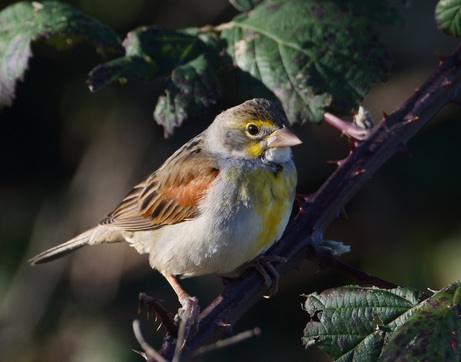 Dickcissel, Bayocean Spit, 21 Nov 2015 Photo: Jack Booth
Dickcissel, Bayocean Spit, 21 Nov 2015 Photo: Jack Booth
Updated 7/12/2020
Tillamook County held a public hearing November 12, 2015 to discuss the future of Bayocean Spit.
Marg Tweelinckx gave the photos of the DICKCISSEL and NORTHERN MOCKINGBIRD provided by Nels Nelson and talked about birding at Bayocean Spit and how it has influenced her.
The Tillamook County Department of Community Development accepted the photos and many people there were interested in the birding.
In a 5-2 vote the Planning Commission voted to change the zoning from Recreation Management (RM) to Recreation Natural (RN), which aims to "... designate and preserve areas that contain significant natural and/or scenic values."
The Tillamook Planning Commission Report may be accessed here.
Additional Bayocean information:
Oregon Coast Alliance
Tillamook County held a public hearing November 12, 2015 to discuss the future of Bayocean Spit.
Marg Tweelinckx gave the photos of the DICKCISSEL and NORTHERN MOCKINGBIRD provided by Nels Nelson and talked about birding at Bayocean Spit and how it has influenced her.
The Tillamook County Department of Community Development accepted the photos and many people there were interested in the birding.
In a 5-2 vote the Planning Commission voted to change the zoning from Recreation Management (RM) to Recreation Natural (RN), which aims to "... designate and preserve areas that contain significant natural and/or scenic values."
The Tillamook Planning Commission Report may be accessed here.
Additional Bayocean information:
Oregon Coast Alliance
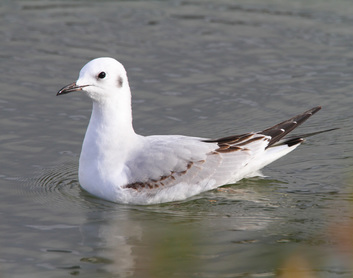 Bonaparte's Gull, Nov 2014 Photo: Jack Booth
Bonaparte's Gull, Nov 2014 Photo: Jack Booth
Do you have photos, notes or field reports you'd like to share, or suggestions about the website? Let us know!
eBird "Hotspot Explorer"
We've added links to eBird's new "Hotspot Explorer" for each of our featured birding locations on our Where to Bird pages. These links take you to a new eBird feature that includes recent sightings, top listers, bar charts and more. They have also added an interface for counties, so here's a link to Tillamook County. More information...
Oregon Birding Sites Guide (new links)
|
What is Tillamook Birder?
Tillamook County is located on the north Oregon coast, between Lincoln county, to the south, and Clatsop, to the north. Its coastline offers rocky ocean beaches, majestic Capes, and numerous bays. Moving inland, fertile fields and wetlands give way to lush forested mountains as you move further east. On our website, we plan to provide up to date reports of birding activity and conditions, information about local birding events, and much more. We plan to keep updating and revising to best meet your needs. Special thanks to Jules Evans, Dawn Villaescusa, Cliff Cordy, Tim Blount, Jack Booth and Ken Chamberlain for their input, advice, and fantastic photos. Editor is Michael Krall.
